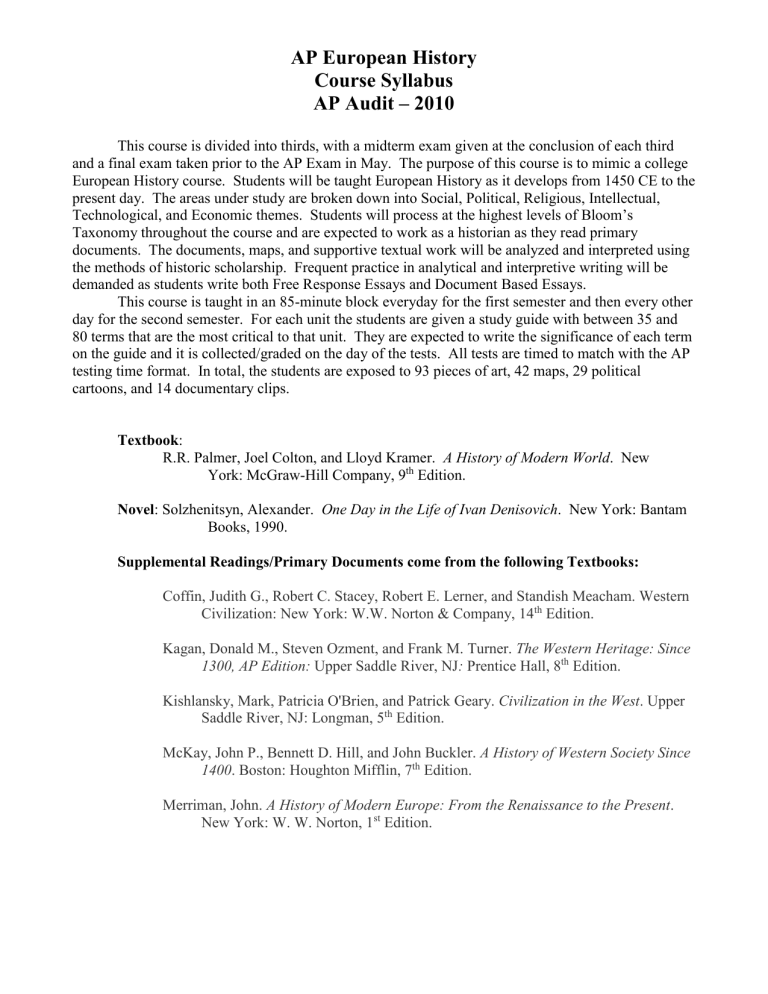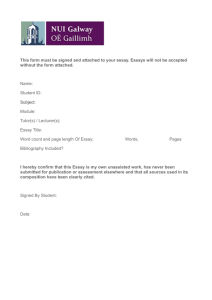AP European History

AP European History
Course Syllabus
AP Audit – 2010
This course is divided into thirds, with a midterm exam given at the conclusion of each third and a final exam taken prior to the AP Exam in May. The purpose of this course is to mimic a college
European History course. Students will be taught European History as it develops from 1450 CE to the present day. The areas under study are broken down into Social, Political, Religious, Intellectual,
Technological, and Economic themes. Students will process at the highest levels of Bloom’s
Taxonomy throughout the course and are expected to work as a historian as they read primary documents. The documents, maps, and supportive textual work will be analyzed and interpreted using the methods of historic scholarship. Frequent practice in analytical and interpretive writing will be demanded as students write both Free Response Essays and Document Based Essays.
This course is taught in an 85-minute block everyday for the first semester and then every other day for the second semester. For each unit the students are given a study guide with between 35 and
80 terms that are the most critical to that unit. They are expected to write the significance of each term on the guide and it is collected/graded on the day of the tests. All tests are timed to match with the AP testing time format. In total, the students are exposed to 93 pieces of art, 42 maps, 29 political cartoons, and 14 documentary clips.
Textbook :
R.R. Palmer, Joel Colton, and Lloyd Kramer. A History of Modern World . New
York: McGraw-Hill Company, 9 th
Edition.
Novel : Solzhenitsyn, Alexander. One Day in the Life of Ivan Denisovich . New York: Bantam
Books, 1990.
Supplemental Readings/Primary Documents come from the following Textbooks:
Coffin, Judith G., Robert C. Stacey, Robert E. Lerner, and Standish Meacham. Western
Civilization: New York: W.W. Norton & Company, 14 th
Edition.
Kagan, Donald M., Steven Ozment, and Frank M. Turner. The Western Heritage: Since
1300, AP Edition: Upper Saddle River, NJ : Prentice Hall, 8 th
Edition.
Kishlansky, Mark, Patricia O'Brien, and Patrick Geary. Civilization in the West . Upper
Saddle River, NJ: Longman, 5 th Edition.
McKay, John P., Bennett D. Hill, and John Buckler. A History of Western Society Since
1400 . Boston: Houghton Mifflin, 7 th
Edition.
Merriman, John. A History of Modern Europe: From the Renaissance to the Present .
New York: W. W. Norton, 1 st
Edition.
First Third of the Course
Unit 1: Renaissance (7 Days)
Topics discussed:
Black Death
Hundred Years War
Early Problems with the Church
Why Italy?
Great Schism
Renaissance Values
Machiavelli’s impact
Authors of importance
Social Changes during the time
Northern vs. Southern Renaissance
Rise of New Monarchies
Test: o 20 Multiple Choice o 5 Term Identification o 1 Essay
Unit 2: Reformation (4 Days)
Reasons for the Reformation
Martin Luther’s actions/beliefs
Reaction to Luther
Peace of Augsburg
John Calvin’s actions/beliefs
Henry VIII and the Anglican Church
More and Erasmus
Spanish Inquisition
Counter Reformation
Role Women played
Test: o 25 Multiple Choice o 5 Term Identification o 1 Essay
Unit 3: Economic Renewal and Wars of Religion (7 Days)
European Knowledge of the rest of the world at the time
Navigation Technology
Colonial Differences
Changing Social Structures
Explorers
New Entrepreneurs
Mercantilism
Educational Changes
Eastern vs Western Europe
Various Royal Family intrigue
Wars of Religion – England, Spain, France, and Holy Roman Empire
30 Years War
Test:
Unit 4: Early Western Leadership (5 Days)
Balance of Power
English Civil War through the Restoration
Glorious Revolution
The reign of the “Sun King”
Versailles vs Escorial
War of Spanish Succession
Test: o 20 Multiple Choice o 1 Essay
Unit 5: Baroque (1 Day) o 40 Multiple Choice o 5 Term Identification o 1 Essay
Major Authors, Artists, Thinkers, Composers
Cervantes, Bodin, Spinoza, Campion, Wren, Racine, La Fontaine,
Boileau, Leibniz, Vivaldi, Milton, Spenser, de Vega, Grotius,
Bekker, Purcell, Corneille, Moliere, Rochefoucauld, Bossuet,
Bach, Handel, de Montaigne
Unit 6: Early Eastern Europe (5 Days)
Formation of Austrian Monarchy
Pragmatic Sanction
Rise of Hohenzollern
Prussian Leadership
Prussian Military Greatness
Social Life in Prussia
Ivan the Terrible
Rise of Romanov Rule
Economic/Social/Political Life under Peter the Great
Polish Liberties and John Sobieski
Test: o 35 Multiple Choice o 1 Essay
Unit 7: Government Changes, Scientific Revolution, & Enlightenment (10 Days)
Popular Culture vs Elite Culture
Post Treaty of Utrecht Europe – political situation
Louis XV’s Court
Tory vs Whig
George I vs Pretenders
Military changes
War for Austrian Succession
Diplomatic Revolution
Scientific Revolution – players/concepts/events
Copernicus, Brahe, Bacon, Galileo, Kepler, Harvey, Descartes,
Pascal, Boyle, Huygens, Spinoza, Hooke, Newton,
Leeuwenhoek, Deductive and Inductive Reasoning, Cartesian
Dualism, Copernican Theory
Enlightenment – players/concepts/events
Hobbes, Locke, Beccaria, Rousseau, Wollstonecraft, Voltaire,
Montagu, Smith, Montesquieu, Diderot, Mendelson, Wesley
Major Enlightenment philosophies
Social Contract, Tabula Rasa, Crime & Punishment, Role of
Women, Separation of Powers, Laissez-Faire, Freedom of
Press/Religion/Speech, Free Market
Encyclopedia
Print Culture emerging
Coffeehouses
Enlightened Despots
Maria Theresa, Joseph II, Catherine the Great, Frederick the
Great
The changing role of family in the economy.
Test: o 25 Multiple Choice o 1 Essay
Midterm Test :
40 Multiple Choice
2 Essays
Art Lessons (Lecture and PowerPoint Presentations):
Renaissance
Baroque
Primary Documents (selections from the following) :
Book of the Courtier , Castiglione
The Prince , Machiavelli
The Decameron , Boccaccio
Book of the City of Ladies , de Pisan
Execution of Archbishop Cranmer , Bystander
A Diatribe Against the Pope , Erasmus
Witchcraft Trial in France , Unknown
Simplicius Simplicissimus , Jakob von Grimmelshausen
They Judged Nothing Worthy of…Celebrating Except what was Rare in our Sex
, van Schurman
Emile , Rousseau
Encyclopedie , Diderot
Second Third of the Course
Unit 8: French Revolution and Napoleon (7 Days)
Differences in Estates – socially and economically
Abuses of Louis XVI and Marie Antoinette
Economic conditions in France
Storming of the Bastille
Estates General to the National Assembly
Political Clubs
Tennis Court Oath
Night of August 4 th
Women’s March to Versailles
Flight and Capture of the Royal Family
Reign of Terror
Rise of Napoleon
Actions of Napoleon – social, economic, political
Women and the Napoleonic Code
Congress of Vienna
Test: o 30 Multiple Choice o 1 Essay
Unit 9: Industrialization and Ism’s (9 Days)
What is industrialization?
In depth look at Manchester, England
Child Labor
Environmental effects
Agricultural Revolution
Iron Law of Wages and Law of Diminishing Returns
Potato Famine
Social impact of industrialization
Role of Women and Children
Irish Potato Famine
Look at Ism’s
Liberalism, Socialism, Feminism, Republicanism,
Conservativism, Radicalism, Humanitarianism, Nationalism
Revolution of 1830
Revolution of 1848
Impact of Georg Hegel
Realpolitik
Concert of Europe/Metternich
Chartist Movement
Rise of Whigs and Tories in Britain
Decembrist Revolt
Karl Marx and his philosophy
Test: o 50 Multiple Choice o 1 Essay
Unit 10: Unification and Pre-WWI (6 Days)
Italian Unification
German Unification
Dual Monarchy
Russian Reforms under Tsar Alexander II
Differences between Inner and Outer Europe (Economic, Social,
Technological)
Urban Life
Atlantic Migration
Globalization of Economy
Paris Commune and 3 rd
Republic
Dreyfus Affair and Zionism
Gladstone vs. Disraeli
Victoria Age
Ulsterman conflict
Fabian Socialists vs. Marxists
Pankhurst and the Feminist movement
Social Darwinism
Science of Mendel, Pavlov, Freud, Curie, Becquerel, Einstein
Nietzsche – Genius or Madman?
Test o 40 Multiple Choice o 10 Art Identifications o 2 Essays
Unit 11: Imperialism (3 Days)
White Man’s Burden
European Scramble for Africa
British methods of control in India
Suez Canal fight
Boxer Rebellion
Ottoman Empire as the Sickman of Europe
Sepoy Mutiny
Unit 12: WWI (6 Days)
Generalizations
Causes
Balkan Crisis
Zimmerman Telegram
Schlieffen Plan
Women and the War
Homefront
Tactics and Technology unleashed in this War
The Lost Generation
Treaty of Versailles and its effect
Test: o 20 Multiple Choice o 10 Map and Political Cartoon Identifications
Midterm Test :
41 Multiple Choice
2 Essays
Art Lessons (Lecture and PowerPoint Presentations):
Neoclassicism
Goya
Romaticism
Primary Documents (selections from the following) :
What is the Third Estate?, de Sieyes
Declaration of the Rights of Man and Citizen
French Women Petition to Bear Arms , Leon
, Lafayette
Declaration of the Rights of Woman and Citizen , de Gouges
An Essay on the Principle of Population , Malthus
The Black Holes of Worsley , British Government Report
How They Kept the Children Awake
, Report of Sadler’s Committee
Treatise on the Management of Pregnant and Lying-In Women, Young
Concerning Germany , De Stael
On Liberty , Mill
Philosophy of History , Hegel
Communist Manifesto
Confessions of Faith
, Marx
, Rhodes
Manifesto for the Society for German Colonization , Peters
The Boxers Demand Death for all “Foreign Devils”,
I-ho-ch’uan
Gunga Din, Kipling
Testament of Youth: An Autobiographical Study of the Years 1900-1925 , Brittain
Final Third of the Course
Unit 13: Russian Revolution (7 Days)
Economic condition in Russia circa 1917
Tchaikovsky and Rimsky-Korsakov
Tolstoy
Political Parties during the Revolution
Reforms of Stolypin
Bloody Sunday
Rasputin’s influence
March and November Revolutions
Kerensky and the Provisional Government
War Propaganda
Reds vs Whites vs Greens
Rise of Lenin and Trotsky
War Communism
Methods of Control
Rise of Stalin
Government and Communist Party Structure
New Economic Policy
Battleship Potemkin
Role of Women in Revolution
Role of Women in Soviet Society
Collectives
Purges
Third International
Discussion on the major themes of One Day in the Life …
Test: o 22 Multiple Choice o 2 Essays
Unit 14: Between the Wars (6 Days)
Interwar Culture: Artist and Intellectuals
German Governmental Changes under the Weimar Republic
Reactions to the Treaty of Versailles
Economic impact of Reparations
Spirit of Locarno
Kemal (Ataturk) and his changes to the Turkish Empire
Impact of Inflation and Currency Depreciation
Causes of the Great Depression
Rise of Fascism
Stream of Consciousness
Popular Front and Leon Blum
Political Party Changes in Great Britain
Impact of the Radio upon Politics
Rise of Mussolini
Rise of Hitler
Hitler’s policies of anti-Semitism and on women
Politics in Poland, Czechoslovakia, Hungary, & Austria during time
Unit 15: WWII (5 Days)
Maginot Line
League of Nations’ failures
Spanish Civil War
German Territorial Gains
Munich Conference
Anschluss
Technology and tactics of the War
Miracle at Dunkirk – Churchill
Vichy France (Laval and Petain)
Home front
Resistance Movements through Europe
Turning Points in the War (Pearl Harbor, Stalingrad, Operation Overlord,
Hitler’s Suicide, VE-Day)
Holocaust and Final Solution
Conferences to End the War (Casablanca, Teheran, Yalta, Potsdam)
Test o 15 Multiple Choice o 2 Political Cartoon Analysis o 4 Art Identification o 5 Term Identification
Unit 16: Cold War – Western Europe (7 Days)
Changes to the Map due to WWII
United Nations structure and powers
Balfour Declaration and UN Resolution 242
Causes of the Cold War
NATO vs. Warsaw Pact
Division of Germany and the ensuing problems
Berlin Wall – rise and fall
Differences in economic handling of German Rebuilding (East & West)
Population changes (pyramids)
Economic Miracles of Rebuilding
Marshall Plan
Mixed Economy
Welfare State
Guest Worker problem
Keynesian Economic Policy
Decolonization
Christian Democrats vs. Social Democrats vs. Free Democrats
Britain’s political party woes
Actions of Charles DeGaulle
Italians and Euro communism
Modern Feminism
The Permissive Society/Drug Culture
Student Revolts (esp. 1968 France)
New European Economic Organizations (GATT, WTO, IMF, World Bank,
Council of Europe, Benelux, EEC, EU)
French Fifth Republic
Britain – Labor vs. Conservatives
New German Government Structure
Stagflation and Supply-Side Economics
Thatcher’s Throw-Back policies
Test o 2 Map Identification o 2 Essays o 50 Multiple Choice
Unit 17: Cold War – Eastern Europe (5 Days)
Why did the Soviet Union Collapse?
Comecon and the Economic Trading Blocs
Dr. Zhivago
Space Race
Yugoslavia and Tito
Soviet Repression in Eastern Bloc countries
Suez Crisis
Hungarian Uprising
SALT talks
Brezhnev Doctrine
Détente
Prague Spring
Velvet Revolution and Vaclav Havel
Solidarity and Lech Walesa
Perestroika and Glasnost
Rock Music and Protests
Nuclear Proliferation
Gorbachev as a reformer
The “German Question”
Rise of Yeltsin and end of USSR
Test: o 35 Multiple Choice o 1 Essay
Unit 18: Post Cold War (2 Days)
Purges in Eastern Bloc countries
Economic and Social problems faced by Yeltsin
Social issues faced in Yugoslavia
Dayton Accords
IRA
Green Party Movement
Chernobyl
Revival of Religion
Mass Sports
Globalization of Civilization
Velvet Divorce
Existentialism
Growth of Terrorism
Unit 19: Review for AP Exam
Break down of each unit based on the themes of AP program
Unit 20: Post Exam Final Project
Midterm Test :
55 Multiple Choice
1 Essay
Art Lessons (Lecture and PowerPoint Presentations):
Impressionism
Post-Impressionism
Expressionism
Fauvism
Cubism
Surrealism
Abstract Expressionism
Primary Documents (selections from the following) :
Five Sister: Women Against the Tsar , Kovalskaia
Stalinism as a Way of Life: A Narrative in Documents , Siegelbaum and Sokolov
Women in a Changing Civilization , Holtby
On Emancipation of Women , Hitler
The Use of Radio for Political Propaganda , Goebbels
Hitler’s Secret Conversations, October 17, 1941
, Hitler
Diary of a German Soldier , Unknown
Night , Wiesel
Diary of Anne Frank , Anne Frank
The Second Sex , de Beauvoir
A Student Manifesto in Search of a Real and Human Educational Alternative , Student at
University of British Columbia
The Secret Speech , Khrushchev
Speech to Congress, February 21, 1990
Perestroika , Gorbachev
Final Exam:
, Havel
The entire released AP Exam. Timed and scored according to the guidelines
80 Multiple Choice
1 DBQ
2 FRQs





